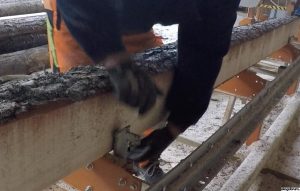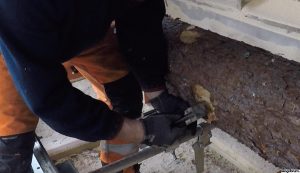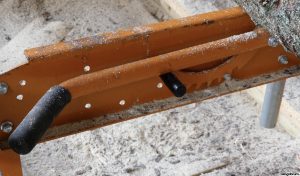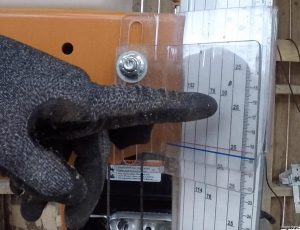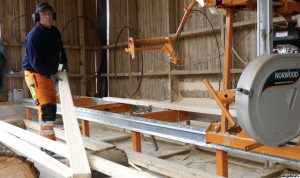South Swedish forest owner Kjell Ljungberg bought his first Norwood sawmill last year. Now he processes saw logs from his own forest into lumber that he uses within his estate. Together with his wife Maria he runs a business with, among other things, rental cottages. The need for sawn timber is big at the farm, and the word goes around that the lumber Kjell produces is of high quality. So, also other eager customers have turned up.
Norwood Lumbermate – simple and reliable
Kjell wanted a simple and robust model. One with no automatic functions but that is easy to use. The choice became the Norwood Lumbermate LM29.
He placed the Norwood in a barn that was transferred into a sawmill. The barn has two open sides and room enough for air drying quite a lot of lumber under the same roof as the sawmill. Kjell choose a 14 hp petrol-driven Kohler engine, but Norwood also offers a 7,5 hp electrical motor as an option if that is preferred. The saw itself, is a bandsaw.
The Lumbermate LM29 has manual feeding and manual settings. It is equipped with a smart and simple dimension table that helps you to get the right thickness of the boards depending on which dimensions you want to get from the log.
Handling the logs
According to the manufacturer, the Lumbermate LM29 can handle logs up to 74 cm diameter and the efficient cut is 56 cm. This could be compared to the largest Norwood model, the LumberPro HD36, that manages respectively 92 and 71 cm.
All actions of lifting, rolling and strapping logs or blocks, and also lifting the top end of the log, is done by hand. However, there are a number of simple and smart solutions to facilitate those actions. According to the manufacturer, Norwood has more patented details than any other manufacturer of portable sawmills.
Bandsaw in flat packages
The Norwood Lumbermate LM29 was delivered as a DIY kit to be assembled by the customer. According to Kjell, there was quite a lot of “picking” to get it all together properly. A skilled mechanic probably makes it in a day, but Kjell took his time in order to get it right from the start.
The Lumbermate LM29 is also available as a mobile sawmill to pull behind a car. But Kjell wanted the stationary version.
The standard length of the frame of the sawmill is 6 meters. It can be extended with 1,2-meter modules to the desired length.
Simple saw setting
Kjell found it easy to learn how to place the log in the sawmill. The first cut should be parallel to the center of the log. The top end of the log should always be placed towards the bandsaw. With the “top lift”, the top end of the log is lifted so that the center of the log becomes horizontal – meaning that the center is as high above the frame at both ends of the log.
After the first cut, it´s possible to cut one or more unedged boards before the log is turned, if the log is thick. A thin log could be turned 180° directly after the first cut, to be cut on the other side, parallel to the first cut. You can then either saw unedged boards and remove the edges later, or you can remove the slabs to get a block (or cant) and make square-edged boards directly.
This process will be clarified in the film below.
Less sawdust with a bandsaw
Simple and cheap bandsaws have become popular. Many manufacturers confirm that the sales of those increases. One explanation could be that the prices are right for many customers. You don´t have to make any advanced production calculations to make the decision to invest in a bandsaw.
Another explanation could be that the bandsaws are taking market shares from the previous popular sawmills with chainsaw. The bandsaws produce much less sawdust. The saw kerf for a bandsaw is only 2 mm, compared to 5-6 mm with a chainsaw. The bandsaw not only produces less sawdust and more sawn timber, with the thin saw the sawing goes much faster. Many bandsaws can also handle very thick logs.
Mainly softwood timber
The saw logs that Kjell processes in his Norwood mill come from his own forest. Some are windthrown and some are damaged by the bark beetle. Most of the logs he uses are softwood that he selects in the stands. As he has a lot of gravelly soil, he picks out the spruce trees (Norwegian Spruce) to grow good stands of pine forest (Scots Pine). He uses an old Rottne Blondin to bring the logs to the mill.
The spruce is mainly sawn in 1” boards for paneling. The pine timber is sawn in 2” studs or board for construction timber.
Winter and springtime job
Kjell uses his Norwood mill mainly during winter and early spring. This year it has been possible to saw all the time as there has been no frost in south Sweden. That meant that he was finished for the season already in February this year.
The sawn timber is stacked under the same roof as the sawmill and stays there for approximately one year until the next season starts. Then, the dried lumber is moved to another barn to await its final use.
Economy
Is it profitable?
“Yes,” says Kjell and continues. “If you have needs of lumber for your own use it is profitable. If you have an estate with e.g. big barns to maintain you will need quite a lot of sawn timber that is expensive to buy. Then it´s cheaper to take the wood from your own forest and process it yourself. Also, the home-made sawn timber holds much better quality than what you get in the stores.”
Kjell calculates that the cost for his home-made lumber is about 1/3 of the price he would have to pay in stores. The 2/3 that he saves makes it easier to gain payback on the investment.
“And it´s great fun”, he adds. “It´s very pleasant to do your own lumber. Not to mention that it´s good exercise, the pedometer reveals that I make 10 000 – 11 000 steps per day, only by working at my Norwood mill.”
More on portable sawmills and a film
We have written about other portable sawmills here at NordicWoodJournal.com. Here you can read about the Logosol B1001. And here about the Woodmizer LT70.
Here is a film of Kjell working with his Norwood Lumbermate LM29:
Film, photos and original Swedish text: Torbjörn Johnsen






